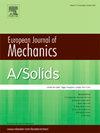Evaluation of the ability of full-field displacement measurements to extract yield surface parameters
IF 4.4
2区 工程技术
Q1 MECHANICS
引用次数: 0
Abstract
We explore the ability of using volumetric three-dimensional (3D) full-field displacement measurements on a single specimen geometry to extract the parameters that describe an isotropic yield surface that depends on all three stress invariants. This is attempted via a numerical study (including specimen design) to investigate the sensitivity of a residual function constructed based on full-field displacement data to the constitutive model parameters. Overall, the sensitivity of the residual function to the parameters is low and this is expected to make the extraction of the parameters to be sensitive to measurement noise. Nonetheless, when the yield surface evolves self-similarly with plastic strain, the calculations show that the multi-axial yield strength can be predicted to a high level of accuracy. Remarkably, such predictions do not require a complex 3D specimen geometry but can also be made to the same level of fidelity using relatively simple notched plane stress or axisymmetric specimens. However, the ability to predict a non self-similarly evolving yield surface is much more limited for all types of specimens. Equally, if the wrong form of the constitutive model is assumed the magnitude of the residual function is shown not to be a good indicator of the poor choice of the constitutive model. We speculate that for the relatively low order constitutive models explored here, adding more displacements data (e.g. 3D data versus 2D data) results in minimal information gain. Rather, additional independent data such as elastic strain measurements might alleviate some of the issues associated with parameter extraction highlighted in the study.
求助全文
约1分钟内获得全文
求助全文
来源期刊
CiteScore
7.00
自引率
7.30%
发文量
275
审稿时长
48 days
期刊介绍:
The European Journal of Mechanics endash; A/Solids continues to publish articles in English in all areas of Solid Mechanics from the physical and mathematical basis to materials engineering, technological applications and methods of modern computational mechanics, both pure and applied research.

 求助内容:
求助内容: 应助结果提醒方式:
应助结果提醒方式:


